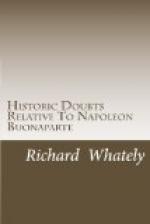on examining the fire-marks around the city, and
the city itself, he became satisfied that the guide
was correct.
“The statement goes on to set forth that the antiquity of the architectural city—particularly of its ’six hundred first-class churches,’ stretching through ante-Napoleonic ages to Pagan times, and showing the handiwork of different nations of History—demonstrates that the city never was burned down (or up).”
The Inquirer adds:
“The Kremlin is a space of several hundred acres, in the heart of the city, in the shape of a flat iron, and is enclosed, by a wall of sixty feet high. Within this enclosure is the most magnificent palace in Europe, recently built, but constructed over an ancient palace, which remains, thus enclosed, whole and perfect, with all its windows, &c.
“Near the Kremlin, surrounded by
a wall, is a Chinese town,
appearing to be several hundred years
old, still occupied by
descendants of the original settlers.
“The circumstances which gave rise to the errors concerning the burning of Moscow, were these:—It is a city of four hundred and fifty thousand inhabitants, in circular form, occupying a large space, five miles across. There the winters are six months long, and the custom was, and still is, to lay up supplies of provisions and wood to last six months of severe cold weather. To prevent these gigantic supplies from encumbering the heart of the city, and yet render them as convenient as practicable to every locality, a row of wood houses was constructed to circle completely round the city, and outside of these was a row of granaries, and in these were deposited the whole of the supplies. Napoleon had entered the city with his army, and was himself occupying the palace of the Kremlin, when, one night, by order of the Russian governor, every wood house and every granary simultaneously burst into a blaze. All efforts to extinguish them were vain, and Napoleon found himself compelled to march his army through the fire. Retiring to an eminence he saw the whole city enveloped in vast sheets of flame, and clouds of smoke, and apparently all on fire. And far as he was concerned it might as well have been, for though houses enough were left to supply every soldier with a room, yet without provisions or fuel, and a Russian army to cut off supplies, he and his army could not subsist there. During the fire some houses were probably burnt, but the city was not. In the Kremlin a magazine blew up, cracking the church of Ivan more than a hundred feet up, but setting nothing on fire.
“Mr. Douglas saw the fire-marks
around the city, where wood
houses and granaries for winter supplies
now stand as of old; but
there appears no marks of conflagration
within the city.”




